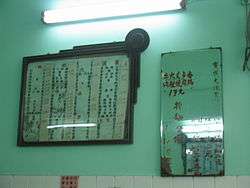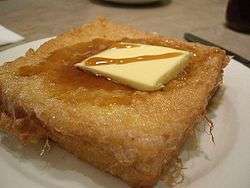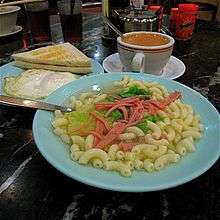Cha chaan teng
Cha chaan teng (Chinese: 茶餐廳; Cantonese Yale: cháhchāantēng; "tea restaurant"), often called Hong Kong-style cafés in English,[1] is a type of restaurant originated in Hong Kong. Cha chaan teng locations are commonly found in Hong Kong, Macau, and parts of Guangdong. Due to the waves of mass migrations from Hong Kong in the 1980s, they were established in major Chinese communities in Western countries such as Australia, Canada, the United Kingdom, and the United States. The cafés are known for eclectic and affordable menus, which include dishes from Hong Kong cuisine and Hong Kong-style Western cuisine.[2] They draw comparison to Western Cafés due to their casual settings, as well as menus revolving around coffee and tea.
| Cha chaan teng | |||||||||||||||||
|---|---|---|---|---|---|---|---|---|---|---|---|---|---|---|---|---|---|
| Traditional Chinese | 茶餐廳 | ||||||||||||||||
| Simplified Chinese | 茶餐厅 | ||||||||||||||||
| Jyutping | caa4 caan1 teng1 | ||||||||||||||||
| Literal meaning | "tea restaurant" | ||||||||||||||||
| |||||||||||||||||
History
Since the 1850s, Western cuisine was only found in Hong Kong from full-service restaurants. They were then a privilege limited for the upper class, and financially out of reach for most working class locals. In the 1920s, dining in a Western restaurant could cost up to $10, while a working local earned $15 to $50 per month.[3] After the Second World War, Hong Kong culture was influenced by British culture. Hong Kong people started to like adding milk to tea and eating cakes. Therefore, some Hongkongers set up cha chaan tengs that targeted a local audience.[4] Providing different kinds of Canto-Western Cuisine and drinks with very low price led to them being regarded as "cheap western food", or "soy sauce western food" (豉油西餐).
In the 1950s and 60s, cha chaang tengs sprang up as rising lower class incomes made such "western food" affordable,[5] causing "soy sauce western restaurants" and bing sutt ("ice rooms") to turn into cha chaan teng[6] to satisfy the high demand of affordable[5] and fast Hong Kong-style western food.[6]
In recent years, the management of cha chaan tengs has adapted with developments in the Hong Kong economy and society. During the 1997 Asian Financial Crisis, cha chaan tengs became much more popular in Hong Kong as they still provided the cheapest food for the public.[7] In April 2007, one of the Hong Kong political officers suggested that cha chaan teng be listed in the UNESCO Intangible Cultural Heritage Lists, because of its important role in Hong Kong society.[8] In June 2014, a number of famous dishes in cha chaan teng—namely milk tea, yuenyeung, pineapple bun, and egg tart were enlisted into the first Intangible Cultural Heritage Inventory of Hong Kong.[9]
Name and description
The name, literally "tea restaurant", serves to distinguish the restaurants from Western restaurants that provide water to customers instead of tea. Cha chaan teng establishments provide tea (usually weak tea) called "clear tea" (清茶 cing1 caa4), to customers as soon as they are seated. (Some patrons use this hot tea to wash their utensils, a common custom in Hong Kong.) The "tea" in the name refers to this inexpensive black tea, which differs from the traditional Chinese tea served in traditional dim sum restaurants and teahouses (茶樓).
The "tea" may also refer to tea drinks, such as the Hong Kong-style milk tea and iced lemon tea, which are served in many cha chaan tengs. The older generations in Hong Kong refer to dining in these restaurants as yum sai cha (飲西茶; lit: "drinking Western tea"), in contrast with the going yum cha.
Some cha chaan tengs adopt the word "café" in their names. This is especially the case when located in English speaking countries where they are commonly known as "Hong Kong–style cafes" and are instead best known for their serving of yuenyeung and Hong Kong–style (condensed milk) coffee.
Culture
.jpg)
Fast service and high efficiency
Usually, tea restaurants have high customer turnover, at 10–20 minutes for a sitting. Customers typically receive their dishes after five minutes. The waiters take the order with their left hand and pass the dishes with their right hand. This embodies Hong Kong's hectic lifestyle. During peak periods, long queues form outside many restaurants.
Long working hours
The staff in a cha chaan teng work long hours, sometimes also night shifts.
Trend
Because of the limited land and expensive rent, cha chaan tengs are gradually being replaced by chain restaurants, such as Café de Coral, Maxim's and Fairwood. As chain restaurants dominate the market, Hong Kong's cha chaan teng culture is disappearing. They are however increasing in popularity overseas with many opening up in Cantonese diaspora communities as a casual alternative to more traditional Chinese Restaurants.[10][11][12]
Common phrases and abbreviations
To speed up the ordering process, waiters use a range of abbreviations when writing down orders.
- The character 反 (spoken as faan, meaning "opposite") is used to represent 白飯 (baak faan, meaning "white rice").
- "0T" stands for lemon tea (0 reads as ling, which is phonetically similar to the first word of lemon (檸) which is ning and phonetically identical to how most Hong Kong people now pronounce 檸. T stands for "Tea").
Customers similarly use special phrases when ordering:
- 走冰 (zau bing, lit. "leave (depart) ice") or 走雪 (zau syut, lit. "leave snow") ― To order cold drinks without ice in them
- 飛砂走奶 (fei saa zau naai, lit. "fly sand leave milk") ― To have the drink prepared without sugar or milk, when ordering coffee or tea
- 茶走 (caa zau, lit. "tea leave") ― Replace milk with condensed milk in milk tea
- 加底 (gaa dai, lit. "add base") ― For extra rice or noodles in a dish, typically costs extra
- 炒底 (caau dai, lit. "stir-fry base") ― For the rice or noodles in a dish to be stir-fried
Menus


.jpg)
A cha chaan teng serves a wide range of food, from steak to wonton noodles to curry to sandwiches, e.g. Hong Kong-style French toast.[13] Both fast food and à-la-carte dishes are available. A big cha chaan teng often consists of three cooking places: a "water bar" (水吧) which makes drinks, toast/sandwiches and instant noodles; a "noodle stall" which prepares Chiuchow-style noodles (including wonton noodles); and a kitchen for producing rice plates and other more expensive dishes.
Food and drinks

Drinks
The invention of drinks like yuenyeung (鴛鴦), iced tea with lemon (凍檸茶) and Coca-Cola with lemon (檸樂) is often credited culturally to this style of restaurant.
- Coffee: Two types exist: instant and in powder form, the latter being more common. Often served with condensed milk, especially overseas.
- Black coffee: Hong Kong people usually called them jaai fea (lit. "vegetarian coffee" / "just coffee", emphasising on its plain texture) or "fei sha jaau naai" (lit. "get rid of sand and milk", i.e. coffee without sugar (the "sand") and milk)
- Hong Kong-style milk tea: A highly popular drink in Hong Kong. Its standard is judged by its aroma, smoothness and concentration. The tea is soaked in an iron container for several hours to let the flavour come out. If the customer wants condensed milk instead of normal milk, people will often say "caa zau" (lit. "tea go")
- Yuenyeung: A mixture of coffee and tea, originated in Hong Kong. According to traditional Chinese medicine, coffee and tea is "hot" and "cold" in nature, respectively. A mixing of both thus then yield the best combination for beverage.
- Black and White Yuenyeung: A mixture of Ovaltine and Horlicks, originated in Hong Kong.
- Horlicks
- Ovaltine
- Lemon Tea
- Lemonade: Commonly served without sugar or syrup.
- Lemon with Ribena
- Lemon with Honey: Often, to reduce cost, the honey is substituted with "Watercress Honey"
- Soft drinks: Coca-Cola, 7-up, Fanta and Cream Soda are some common selections.
Adding ice in a drink may cost an extra fee. Some people simply ask for a glass of ice.
Snacks
- Toast: This includes toast with condensed milk and butter/peanut butter, toast with jam and butter, toast with butter in a sliced form, and French Toast
- Sandwich: Sandwiches found in Cha Chaan Tengs usually include egg, ham, corned beef or a mixture of any as a filling. Club Sandwiches are also very common. A difference between the sandwiches found in Cha Chaan Tengs, and other eateries would be that only white bread is used, the customer has the option of omitting the crust of the bread, and requesting that the bread be toasted before making their sandwich.
- Egg tart
- Hong Kong-style buns: Includes pineapple buns (with or without a slab of butter inside), cocktail buns, Satay beef buns, barbecued pork buns, etc.
- Spring rolls
Fried dishes
- Various Fried rice and noodles dishes
- Hong Kong-style spaghetti bolognese
- Fried instant noodles
- Beef chow fun
Soup dishes
- Instant or udon noodles in soup
- Macaroni in soup
- Soup noodles with fish balls, wontons and the like
Miscellaneous dishes
- Barbecued Pork (Char siu): Not found in all cha chaan tengs.
- Congee and yau ja gwei, a Chinese fritter.
Set meals
A feature found in cha chaan tengs are set meals. There are various sets available throughout the day for breakfast, lunch, afternoon tea and dinner. The lunch and dinner sets usually include a soup and a drink. Generally there is an additional HK$2-3 charge for cold drinks. Sometimes an additional HK$5 is charged for toasting the bread (烘底).
Other sets include:
- "Nutritious set" (營養餐) – It comes with milk and other nutritional food
- "Constant set" (常餐) – Provided all day long, hence the name (it usually consists of a main course, omelette, wheat foodstuff, white bread with butter and a drink) The wheat food stuff always comes with different choices such as spiced pork cubes, salted vegetable with sliced pork or luncheon meat etc.
- "Fast set" (快餐) – Immediately served (usually rice with sausages/ ham/ fried eggs with gravy)
- "Special set" (特餐) – Chef's (or Boss's) recommendation
Tables and seats
Generally, the tables in cha chaan tengs are square for 4 people, or round for 6 to 8 people. For each table, there is a piece of glass that covers the top and some menus are placed between the table and glass. During lunch or dinner, customers are sometimes requested to "daap toi" (撘枱), meaning they share a table with other customers, who are already seated before. This helps save space, provide waiting guests with seats faster, and give customers in a hurry a seat.
Hygiene
Before 2007, most cha chaan tengs allowed people to smoke, and some waiters would even smoke when working. Since 1 January 2007, Hong Kong Law prohibits smoking within the indoor premises of restaurants.
Interiors and utensils
Much of the plastic-ware found on the table is provided by beverage companies, which is a form of advertising. This plastic-ware includes containers holding toothpicks, plastic menu holders, etc. Brands like Ovaltine, Horlicks and Ribena are the usual providers. To minimise costs, cha chaan tengs also rarely have utensils that bear their own brand name. As a result, the same utensils can be found in many different cha chaan tengs, even different chains. These utensils can be bought in supermarkets, department stores, and stores specializing in restaurant supplies.
Walls and floors in cha chaan tengs are often tiled, because they are easier to clean (especially in the humid summer weather in a city like Hong Kong).
Variations
Other kinds of local restaurant related to cha chaan teng in Hong Kong include chaan sutt (餐室; lit. "meal chamber"), bing sutt (冰室; lit. "ice chamber"), and bing teng (冰廳; lit. "ice dining room"), which provide a lighter and more limited selection of food than cha chaan teng.
In the old days, these eateries only sold different types of "ice", sandwiches and pasta but no rice plates. However, some of the restaurants bearing these titles today ignore the tradition, and provide all kinds of rice plates and even wonton noodles. Original chaan sutts, bing sutts and bing tengs, which can be regarded as the prototype of cha chaan tengs, are now scarce in Hong Kong.
In June 2009, Hong Kong retail design store G.O.D. collaborated with Starbucks and created a store with a "Bing Sutt Corner" at their store on Duddell Street. It is a concept that fuses the retro Hong Kong teahouse, style with the contemporary look of a coffeehouse.[14][15]
In media and popular culture
- The similarities between the different set meals were satirised by My life as McDull, a McDull movie.
- An important part of Hong Kong culture, cha chaan teng is featured in many Hong Kong movies and TV dramas:
- Featured in popular sitcom Virtues of Harmony, a TVB-made soap opera tells the story of a family who runs a cha chaan teng, usually boasting the egg tart and "silk-stocking milk tea" produced by them.
- Stephen Chow played a cha chaan teng waiter in the 1998 comedy The Lucky Guy (行運一條龍), and a cha chaan teng meal-delivery-boy in King of Comedy (1999).
- Some beverage companies put the term cha chaan teng on their products, such as "cha chaan teng milk tea" and "cha chaan teng lemon tea".
- On 19 December 2007, lawmaker Choy So Yuk proposed during a legislative council session that Hong Kong's cha chaan teng be recognised and put up to UNESCO as an "intangible cultural heritage of humanity". The proposal came about after a recent Hong Kong poll found that seven out of ten people believe the cafes deserve a UNESCO cultural listing.[16]
See also
- Cantonese restaurant
- Cha chaan teng buffet
- Dai pai dong
- Dhaba Indian diner
- Greasy spoon
- Kopi tiam
- List of restaurants in China
- List of tea houses
- Macanese cuisine
References
- "Hong Kong-style Diner | Hong Kong Tourism Board". www.discoverhongkong.com. Retrieved 22 April 2020.
- Beerman, Jason "Cha chaan teng cheat sheet: What to order at the most popular eateries in Hong Kong" Archived 24 February 2012 at the Wayback Machine CNN Go. 20 February 2012. Retrieved 4 March 2012
- .(December 2018). Titbits Through Time. Chinese Culinary Institute & International Culinary Institute.
- . (28 December 2007). Cha Chaan Teng is not UNESCO Intangible Culture Heritage. Wenwipo.
- . (2006). 茶餐廳與香港人的身分認同. Hong Kong University Press.
- . (6 March 2016). 飲食男女《人物專訪》中環老牌熱狗王 六旬夥計不捨離開:對呢個招牌有感情. Eat and Travel Weekly.
- .(30 January 2008). Eating in Hong Kong: the Ch Chaan Teng. The New York Times.
- . Changing Chinese Foodways in Asia. Hong Kong: Chinese University Press, 2001.
- . (2006). Intangible Cultural Heritage Inventory of Hong Kong. Leisure and Cultural Services Department.
- CNN Travel
- History of Cha Chaan Teng – Yahoo Knowledge
- HKwalker Archived 25 January 2013 at the Wayback Machine
- "40 Hong Kong foods we can't live without" Archived 5 November 2012 at the Wayback Machine CNN Go. 13 July 2011. Retrieved 9 October 2011
- DeWolf, Christopher (21 April 2010). "Hong Kong's best bing sutt: Guide to old-school diners". CNN Travel. Retrieved 4 March 2012.
- Starbucks with Traditional Hong Kong Style
- Chong, Vince (23 December 2007). "Keeping alive a tea café culture". The Straits Times. p. 28.
External links
| Wikimedia Commons has media related to Cha chaan teng. |
- A comprehensive gallery of the cha chaan tengs found in Hong Kong